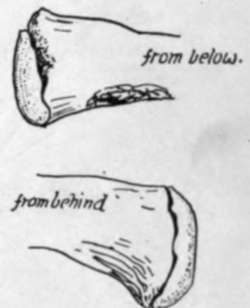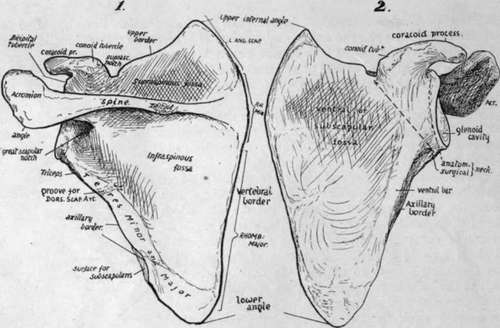Scapula
Description
This section is from the book "The Anatomy Of The Human Skeleton", by J. Ernest Frazer. Also available from Amazon: The anatomy of the human skeleton.
Scapula
A " flat " tone, placed on the postero-external aspect of the upper part of the thorax, connected with the sternum by the clavicle, and carrying the humerus.
Triangular in shape, therefore with three borders and three angles, and a dorsal and ventral surface (Fig. 56). Ventral surface concave, forming the subscapular fossa, covered by and giving origin to Subscapularis : a raised rim along its inner border for insertion of Serratus magnus. Dorsal surface presents the prominent spine, projecting as a free process, the acromion, in a forward and upward direction externally : the spine divides the dorsal surface into an upper supraspinous fossa, and a lower infraspinous fossa, giving origin to muscles of same name : the infraspinous fossa has a narrow area running along its outer side for the two Teres muscles. The spine gives insertion to Trapezius and origin to Deltoid along its upper and lower borders, and these borders are respectively continued into the inner and outer borders of the acromion : where the lower border of spine joins outer border of acromion is the acromial angle. An articular facet for the clavicle occupies the front portion of the inner border of the acromial process : in front of this the acromion presents a free extremity.

Fig. 55.-Epiphysis on end of left clavicle.
The angles are : (a) Lower, covered dorsally by Teres major and ventrally by Serratus magnus : often spoken of as " the angle." (b) Upper and internal, (c) Upper and externa : this carries the glenoid mass, spoken of as the head, which has a glenoid cavity for articulation with head of humerus : the head is joined to the rest of the bone by the neck, which lies outside the free border of the spine : the rest of the main tone is then spoken of as the body.
Borders
Inner or vertebral border thin, gives attachment to Levator anguli scapulae opposite supraspinous fossa, to Rhomboideus minor opposite expanded base of spine, and to Rhomboideus major for the rest of its extent.
Outer or axillary border : sharp, may run somewhat on to dorsal surface between the Teres muscles : below neck has a rough area for origin of long head of Triceps.
Upper border : sharp internally, then presents a marked suprascapular notch for the suprascapular nerve, which is bridged by ligament occasionally ossified : immediately outside this supports a curved projection, the coracoid process, which arises from the border between the notch and the glenoid rim. Coracoid process projects forwards and outwards and turns slightly downwards, therefore has a concave lower surface, inner and outer thick borders, marked by Pectoralis minor internally, and by coraco-acromial and coraco-humeral ligaments externally, and a rough upper surface, which presents a prominent conoid tubercle for conoid ligament behind, and, outside and in front of this, roughnesses for trapezoid ligament : further forward part of Pectoralis minor insertion, and, at the tip, origin of Coraco-brachialis and short head of Biceps. At the base of the process, just above the glenoid cavity, is the bicipital or supra-glcnoid tubercle for the origin of long head of Biceps. The neck is sometimes termed the anatomical neck, lying outside the coracoid, and the term surgical neck is applied to the area crossed by a line drawn from below the glenoid to the notch internal to the coracoid. The lines of both these " necks " pass between the glenoid rim and the free border of the spine : the notch between the rim and spine is sometimes termed the great scapular notch.

Fig. 56.-Dorsal and ventral views of left scapula. To tell left from right hold the spine dorsally, the acromion externally, and the pointed " angle " downwards.
The acromion lies above and rather behind the glenoid fossa, and does not come so far forward as the coracoid process : about an inch and a half separates the tips of the two processes. The upper surface of the acromion and the back surface of the spine are continuous and subcutaneous.
Continue to:
